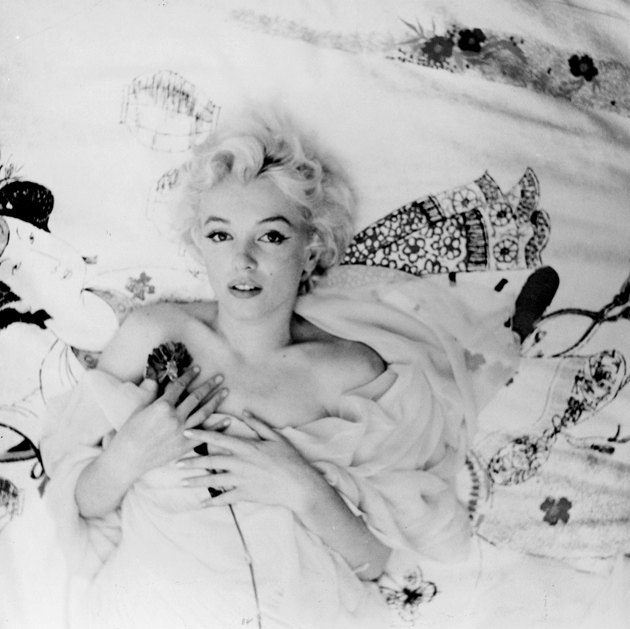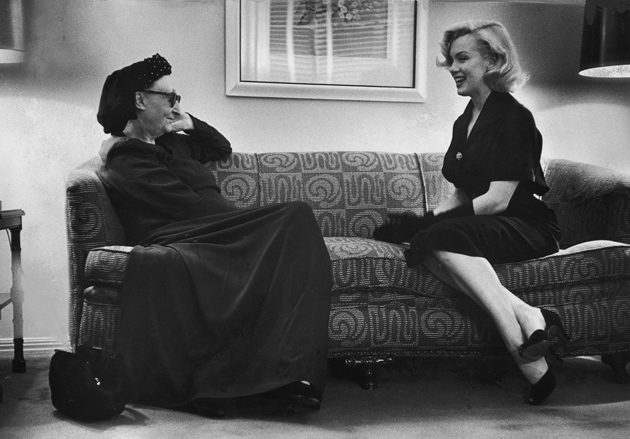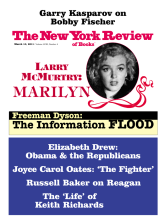1.
She started as a pin-up, that medium of titillation most popular in the 1940s and 1950s. Marilyn spent hundreds of hours in front of the still camera; such was her appeal that the accomplished photographer Richard Avedon reached for superlatives when he spoke of her: “She gave more to the still camera than any actress—any woman—I’ve ever photographed….She was able to make wonderful photographs with almost any photographer, which is interesting—and rare.”
In MM—Personal there is an interesting example of her extreme photogenicity, a shot of her taken from the rear—we don’t see her face at all. She is wearing a black dress and has her hair up. All you see is a rear view of her shoulders and neck, and yet the photograph is as arresting as any in the book. MM—Personal is filled with wonderful photographs, perhaps none finer than the set Cecil Beaton made of her in 1956. (Beaton, himself involved with Greta Garbo, had plenty of practice with superstars.)
In film Marilyn’s talent shows most strongly in Gentlemen Prefer Blondes, How to Marry a Millionaire, Some Like It Hot, Bus Stop, and The Misfits. The director Billy Wilder quarreled with her on Some Like It Hot—but Wilder was no dummy and had this to say about her: “I think she was the best light comedienne we have in films today, and anyone will tell you that the toughest of acting styles is light comedy.”
She was almost always photographed smiling, her lips slightly parted, her skin aglow with an aura all its own, and yet there was usually a curl of sadness in her smile: sadness that just managed to fight through; sadness that was always considerable and sometimes intense.
Consider: she was born in a charity ward of Los Angeles County Hospital in 1926, as Norma Jeane Mortenson (sometimes Nortenson). Her mother, Gladys, worked in lowly film editing jobs; there she met Marilyn’s probable father, Charles Stanley Gifford. Of Gladys, Marilyn said:
I was a mistake. My mother didn’t want to have me. I guess she never wanted me. I probably got in her way. I know I must have disgraced her. A divorced woman has enough problems getting a man, I guess, but one with an illegitimate baby…. I wish, I still wish, she had wanted me.
Gladys’s friend Grace McKee became legal guardian of the little girl as well as Gladys herself after she was diagnosed with schizophrenia; in 1935 Grace put Norma Jeane in the Los Angeles Orphan’s Home (later Hollygrove).
A childhood like that is a feast for Freudians, and explains why, all her life, Marilyn longed for a family and sometimes lived with couples; instead of a family she got endometriosis and three miscarriages. Not knowing your real father and only briefly living with your mother would be a miserable fate for most of us, but for an actress might make it easier to convincingly move into a character, once you’re cast. At last you have somebody to be, somebody an audience will want.
2.
Of the three books under review, easily the most accessible is MM—Personal. Marilyn Monroe, particularly during the decades of the 1940s and 1950s, was arguably the most famous woman on earth. In Korea during the Korean War—of which she was the dominant pin-up—she drew ten thousand soldiers at her appearances. She wrote and received many letters. Here’s a response to one she wrote Somerset Maugham:
Dear Miss Monroe,
Thank you for your charming telegram of good wishes on my birthday. It was extremely kind of you to think of me; I was touched and much pleased.
I am so glad to hear that you are going to play Sadie in the T.V. production of “Rain.” I am sure you will be splendid. I wish you the best of luck.
Yours very sincerely, W. Somerset Maugham
Imagine Marilyn Monroe, the star commonly thought to be an airhead, keeping up with Somerset Maugham’s birthday and taking the trouble to send him a telegram.
This greeting emerged from one of the two tall filing cabinets that, for many years, were thought to be the Rosetta Stone of Marilyn Monroe scholarship; they were in the possession of Inez Melson, Marilyn’s business manager in the mid-Fifties. They contained every scrap of paper Marilyn kept: letters, telegrams, programs, clippings, contracts (even one with Ben Hecht). Inez, who claimed to love Marilyn on sight, said she reminded her of “a fluffy toy.”
There are about ten thousand items in the cabinets, and a selection of them has now been meticulously edited by Lois Banner and photographed, file folders and all, by Mark Anderson. Taken together they provide an appealing overview of Marilyn’s life and the friendships that kept her going. Given her reputation, it is refreshing to see what good taste she had. As soon as she could afford to she wore excellent clothes and kept the receipts, allowing us in some cases to follow the designers.
Advertisement
She was not tight, either. She had a Rodin and a Degas, a 1930s-era fur coat, and was constantly receiving gifts from her admirers: emerald earrings from Frank Sinatra, pearls and jade from the Emperor of Japan, expensive-looking dice from John Huston, who took her gambling in Reno during the filming of The Misfits; Laurence Olivier and Vivien Leigh didn’t like her but nonetheless gave her a pricey watch.
Her books—she had about four hundred—she mostly kept plain: all her Hemingways were from the Modern Library. Most of the time she wrote a good hand; it is to be hoped her letters will be collected someday.
Like many a woman with a troubled childhood and uncertain parentage, as Lois Banner delicately puts it, Marilyn had trouble with men. Her first husband, James Dougherty, vanished into the Merchant Marine. Arthur Miller drifted off. Joe Dimaggio was rough with her. At her death Miller is reported to have said, “Poor Marilyn, with a little luck she might have made it.” Myself, I should have thought she did make it. Men, perhaps jealous of her fame, said unkind things. Tony Curtis famously said that kissing Marilyn was like kissing Hitler. He later explained that he had made the remark flippantly, in response to a workman’s query, which doesn’t make it any less of a rotten thing to say. (There is a photograph of him about to kiss her; he seems anything but reluctant.)
At the height of her fame an issue of Life with her picture on the cover sold 6,300,000 copies, and she was getting 20,000 fan letters a week.
3.
That Marilyn Monroe had an abiding interest in writers, writing, and literature is made plain by more than her telegram to Maugham. There is also the famous photograph, taken on Long Island, of her reading James Joyce’s Ulysses—she appears to be at the very end, which is the Molly Bloom soliloquy: the world’s leading sex symbol reading English literature’s sexiest passage.
She did a lot of jotting herself, wrote down recipes, bits of poetry, and the like. Though she was a smart woman, her scribblings as recorded in Fragments are strangely flat and disappointing:
About My Poems
Norman—so hard to please
When all I want is to tease
So it might rhyme?
So what’s the crime—
after all this time
on earth
Norman is the poet and novelist Norman Rosten, her good friend. Her unrhymed verse is frankly just terrible and the many pages that reproduce the scrawls themselves are so much wasted paper. There are a few appealing pictures of her reading—Leaves of Grass, Death of a Salesman. There is an interesting double-page spread of her books: Sister Carrie, Winesburg, Ohio, The Sun Also Rises, A Farewell to Arms, Tortilla Flat, On the Road, Invisible Man, The Fall.
Two photographs in Fragments are worth mentioning. One is of Marilyn dancing with Truman Capote—Truman looks as if he’s fleeing execution. The other is of Marilyn sitting with Edith Sitwell; it’s the only photograph I’ve ever seen in which Edith Sitwell looks attractive.
We hear enough, in these pages, about her relationship with Frank Sinatra. Personally I would have liked to hear more about her time, during the making of The Misfits, with the aging, weary Clark Gable. Though her tardiness vexed him, Gable loved her, and used his contractual power to keep Arthur Miller from slowing down the shooting with endless rewrites. In many still pictures from that shoot Gable’s fondness shows through, as does John Huston’s.
4.
Two years before she died, Frank Sinatra gave Marilyn a Maltese terrier that she named Maf. Andrew O’Hagan knows a great deal about Marilyn Monroe, and he has chosen to write about her from the point of view of her canine companion Maf the dog—certainly a daring, even a cheeky thing to do. He has made Maf into a very well-read dog. On each of the 277 pages we are likely to find a number of literary references, perhaps to Bloomsbury, perhaps to the German exile community:
Thomas Mann understood how strange it was for a dog to watch everything and say nothing and to live a life of wan good nature, worn out with resting. The German pointer Bashan used to lie beside Mann, the blood-heat of his body pleasing the master and making him feel less lonely. “A pervasive feeling of sympathy and good cheer invariably comes over me when I’m in his company and looking at things from the dog’s angle,” Mann wrote in the middle of his life. As we drove onto the freeway I recalled the story of Theodor Adorno, who pondered the liquification of the individual from a house in the glades of paradise, a house in Malibu that looked into the blue waters of the Pacific Ocean. He may have been a creature of the war years, but his moment came with the 1960s, a decade that really began for us with the fading brightness of Marilyn.
Maf’s story begins at Charleston, the Bloomsbury Charleston of Vanessa Bell, not the one in South Carolina; then, very soon, we’re with Natalie Wood’s mother, a Russian exile; then we come to a passage by Cecil Beaton—to be quoted later—about Marilyn after he took her favorite picture of herself.
Advertisement
Skip now to the dog’s-eye view of Roddy McDowall:
The two women laughed. I gathered Mr McDowall was a great friend to women. They all adored him because he cared in an offhand way about the things that mattered to them. He once said that the French must truly love women because they invented the bidet, and that was the kind of thing women loved him for observing. “This one’s friendlier,” he said, not quite looking at me. “I have to tell you, Lassie was something of a diva.”
To say that the dog Maf has come up with a truly dizzying number of literary references would be to understate. O’Hagan has combed world literature for references to writers and their dogs, and picked up scores. Here, for example, is Vita Sackville-West, who “once spoke of her admiration for a certain French tapestry showing Ulysses being met on the doorstep by his dog, Argos.”
I wish I could claim to have a firm handle on Andrew O’Hagan’s novel, but I don’t. It’s probably safe to call it a tour de force, and less safe to call it a 277-page conceit, which the reader either buys into or doesn’t. Curiously, MM—Personal includes a charming series of letters Marilyn wrote to Arthur Miller’s children from the point of view of their basset hound:
Some terrible insects by the name of ticks have been getting on me lately and Janie it’s just terrible but I am managing the problem pretty well because when I get one on me I just run to Daddy or Marilyn and they get them off me in a hurry.
It’s not clear whether O’Hagan knew of these letters, but he has certainly immersed himself about as deeply as anyone in the world Marilyn inhabited, and its characters. Here’s Kenneth, the once famous 54th Street hairdresser:
They didn’t like dogs at Kenneth’s, the hairdressing salon on 54th Street. Not that it bothered me a great deal. Kenneth was one of those men with a mind like a pecan pie, sticky and dense…. Kenneth always imagined he was about four minutes away from ruling the world…his scissors ready to dive osprey-like into the hair of some turbulent matron….
The novel is full of passages like that. Who actually remembers Kenneth today? Who remembers Roddy McDowall? Plenty remember Frank Sinatra, an important character during the early part of O’Hagan’s book.
Read together the three books remind one of what a lot went out of American life with the passing of Marilyn Monroe; the important thing about her was her spirit, not whether she went to bed with a president and his brother.
5.
Marilyn’s favorite photograph of herself was made by the British photographer Cecil Beaton in New York on February 22, 1956. She liked it so much that Josh Logan, who had just directed Bus Stop, had it framed for her, between two notes from Beaton. Marilyn had dozens of prints of it made. What struck Beaton was her ability to endlessly transform herself—without inhibition but with a real uncertainty and vulnerability:
She had rocketed from obscurity to become our post-war sex symbol, the pin-up girl of an age. And whatever press agentry or manufactured illusion may have lit the fuse, it is her own weird genius that has sustained her flight. Transfigured by the garish marvel of Technicolor cinemascope, she walks like an undulating basilisk, scorching everything in her path…. Perhaps she was born just the post-war day we had need of her. Certainly she had no knowledge of the past. Like Giraudoux’s Ondine, she is only fifteen years old, and she will never die.
The photograph—like many of her photographs—is stunning, but she doesn’t look fifteen and, six years later, she did die, after saying this to a reporter:
It might be kind of a relief to be finished. It’s sort of like you don’t know what kind of a yard dash you’re running, but then you’re at the finish line and you sort of sigh—you’ve made it! But you never have—you have to start all over again.
Richard Avedon said:
Her ideas were always dominated by what she felt her public image should be. She would pore over the contact sheets for hours. She was always looking for what she called an “honest” picture, a “real” or “right” picture.
Marilyn Monroe is buried in a modest little mortuary in Westwood, California. There are several more talent-picked burial places in this world—Westminster Abbey, Père Lachaise, and even Forest Lawn—but none move me as much as that homely little acre in Westwood, where people I might actually have worked with lie. There’s Natalie Wood, ridiculous in full makeup, running down a sand dune that wouldn’t have been there in The Searchers. There’s my own agent, Irving Paul “Swifty” Lazar, there’s Truman Capote, no doubt come to be near Marilyn, there’s Jack Lemmon, there’s Dean Martin, and, greatest of all, there’s Marilyn Monroe, who once said of herself:
Little Norma Jeane, the servant girl. The only way she could be sure people wanted to see her was to make them wait.
How sad is that?
This Issue
March 10, 2011
The Bobby Fischer Defense
How We Know





